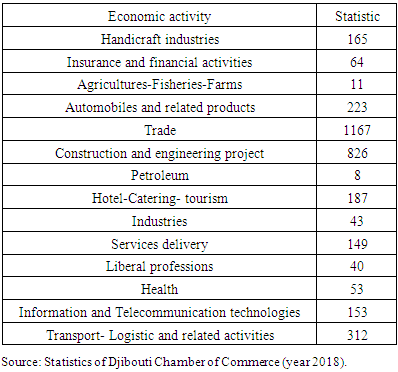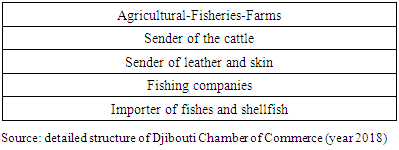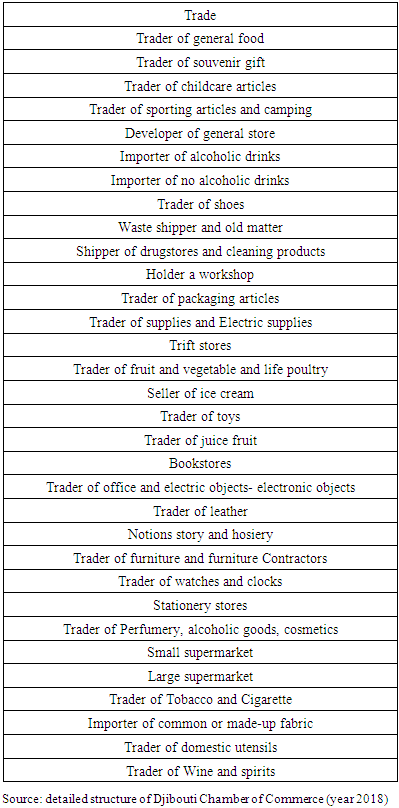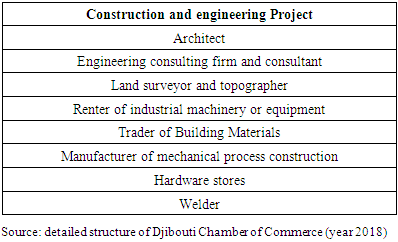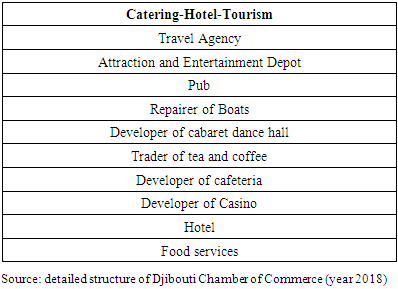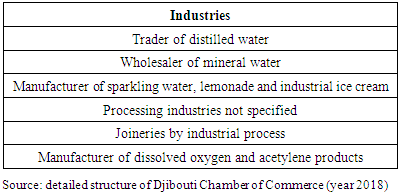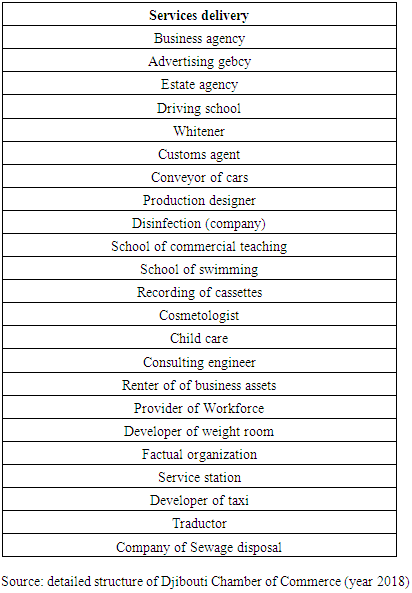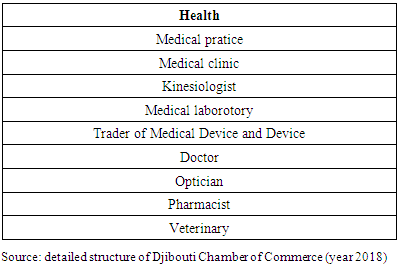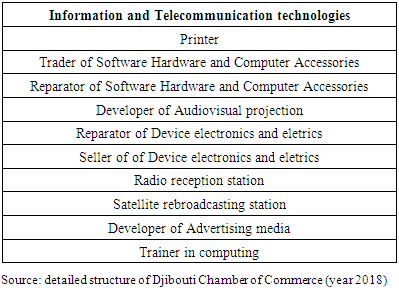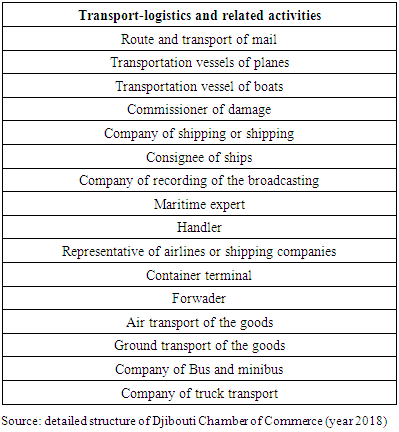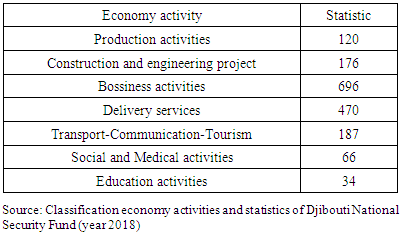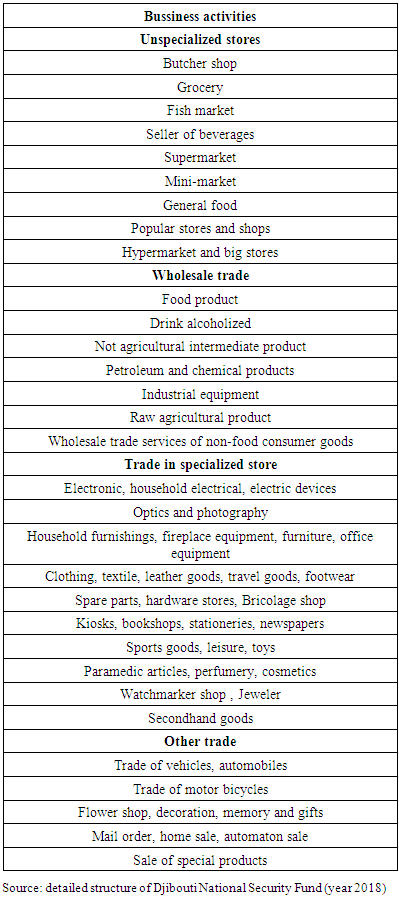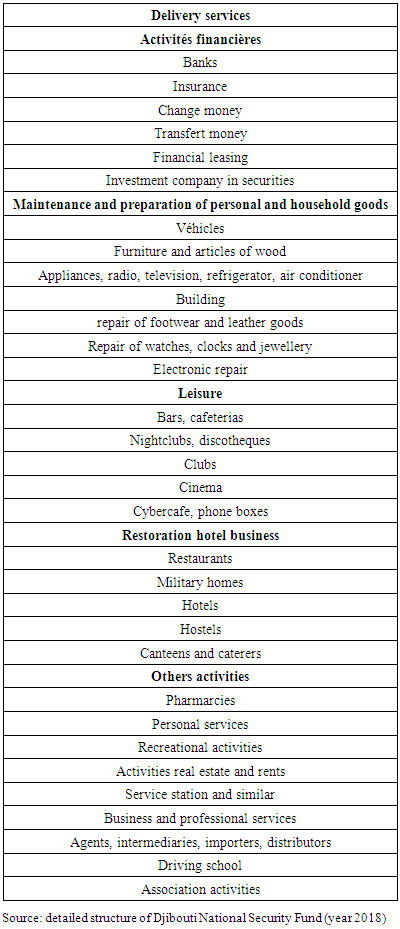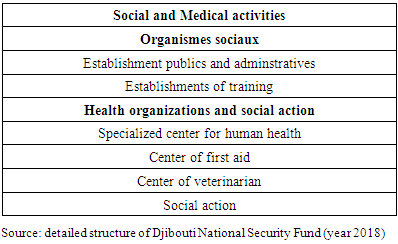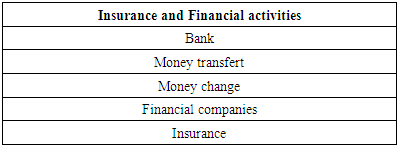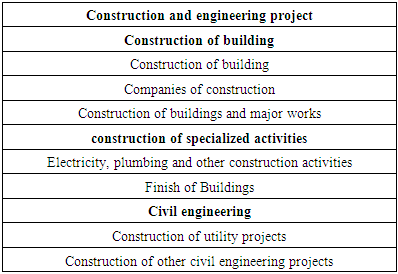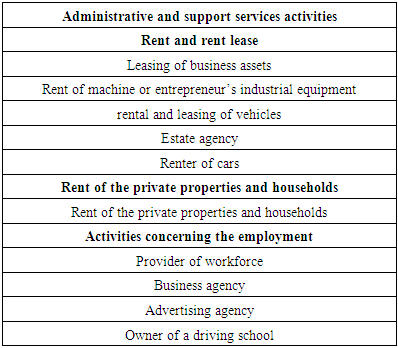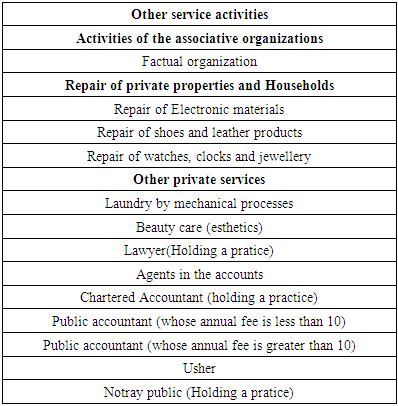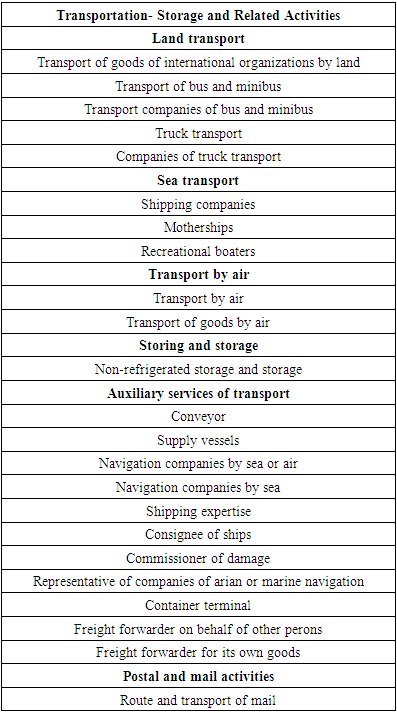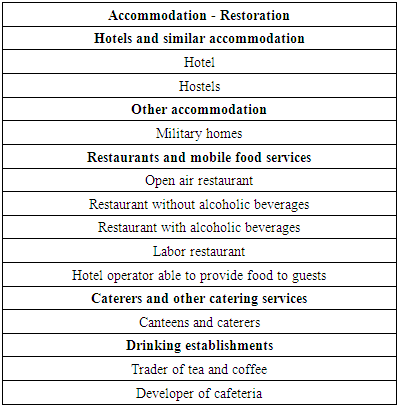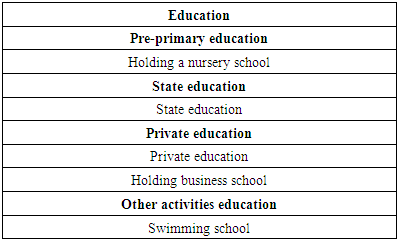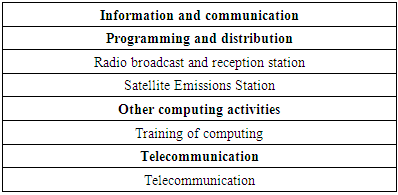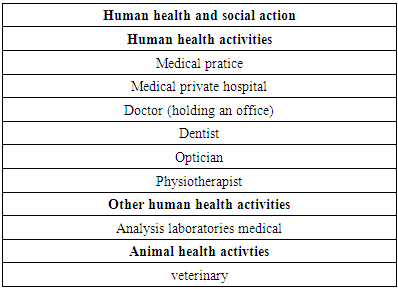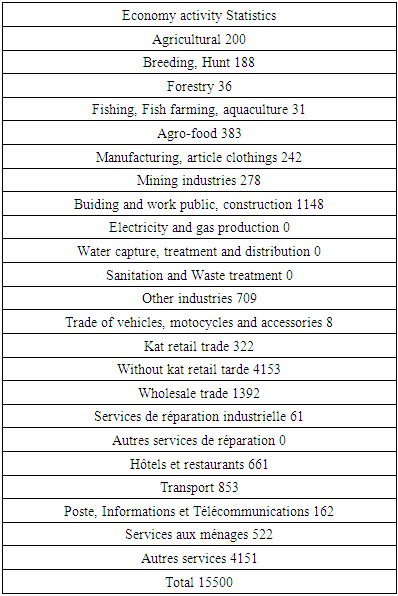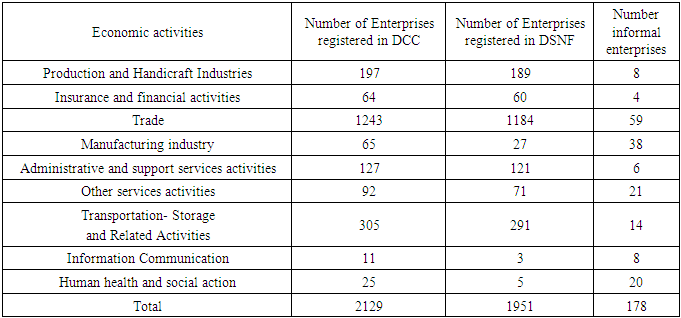-
Paper Information
- Next Paper
- Previous Paper
- Paper Submission
-
Journal Information
- About This Journal
- Editorial Board
- Current Issue
- Archive
- Author Guidelines
- Contact Us
American Journal of Economics
p-ISSN: 2166-4951 e-ISSN: 2166-496X
2019; 9(3): 140-153
doi:10.5923/j.economics.20190903.07

The Formalization of Informal Sector Entrepreneurship in Djibouti: Another Alternative to Reduce the Unemployment
Mohamed Elmi1, Ibrahim Robleh2
1Depatement of Sciences University of Djibouti, Djibouti, Republic of Djibouti
2Department of Economics, University of Djibouti, Djibouti, Republic of Djibouti
Correspondence to: Mohamed Elmi, Depatement of Sciences University of Djibouti, Djibouti, Republic of Djibouti.
| Email: |  |
Copyright © 2019 The Author(s). Published by Scientific & Academic Publishing.
This work is licensed under the Creative Commons Attribution International License (CC BY).
http://creativecommons.org/licenses/by/4.0/

The main aim of this paper is to provide a harmonization of the classification of economic activities in Djibouti based on international classification of economic activities. For this, the paper uses the data reported by Djibouti National security Fund (DNSF) and Djibouti Chamber of Commerce (DCC). The new classification allows to establish a comparison between the informal and formal economics activities. We also estimates the employment created in the informal sector using this new approach. According to our new approach, there are at least 178 enterprises in the informal sector and at least 790 employments in the informal sector. These informal employments can move to 790 formal employments. In the preceding work, we provided a classification of unemployed people and classified economic activities belong in the illegal sector. Then, we estimated there are at least 15670 employment opportunities which allows to reduce the unemployment of order 6¨%. This contribution allows to lower unemployment in Djibouti and provide useful guidance for policy makers in the Republic of Djibouti.
Keywords: Unemployment, Entrepreneurship, Informal sector, Formalization, Classification economy activities
Cite this paper: Mohamed Elmi, Ibrahim Robleh, The Formalization of Informal Sector Entrepreneurship in Djibouti: Another Alternative to Reduce the Unemployment, American Journal of Economics, Vol. 9 No. 3, 2019, pp. 140-153. doi: 10.5923/j.economics.20190903.07.
Article Outline
1. Introduction
- The concept of informal sector was used in the early 1970’s to describe the underground economic activities [25] but it has taken many dimensions and has raised debate in both academic and policy circles. In the sequel, it was defined the concept of informal entrepreneurship [3] and the employment in the informal sector and informal employment [2]. In view of to the growth activities informal sector, the international Expert Group informal sector statistics (Dehli group) has proposed the measurement of informal employment and employment in the informal sector, see [11] or [14] and [9]. All these notions vary in different countries due to the nature and composition of informal sector.The republic of Djibouti maintains a growth rate of 7% in 2017, see [22]. These good macroeconomic figures do not create jobs for the young out of whom 80% are jobless, see [1]. In the republic of Djibouti, there exists three type of enterprises: the enterprises registered at Djibouti National Security Fund (DNSF), those registered at Djibouti Chamber of Commerce (DCC) and the thirty which are illegal. As other countries, our study is then to give a national definition of informal sector enterprises and to measure the generated employment. This definition is linked to the definition of employment in the informal sector adopted by the International Labour Office in 1993. Another observation concerns the institutions like that DCC and DNSF do not have the same definition of informal sector enterprises. Our contribution provides a harmonization of economic activities of both institutions (DCC and DNSF). Another part of our study completes the preceding article, see [1] regarding the employment opportunities which exist in the illegal entrepreneurships. The purpose of this paper is to formalize the entrepreneurships in the informal sector and illegal entrepreneurships. This will allow to create the formal employments and then to reduce the unemployment in the Republic of Djibouti (the rate of unemployment that is 48%). In the sequel, this paper is organized as follows: Section 2 gives background and literature reviews. Section 3 presents a national definition of enterprise in the informal sector and we also provide the different classification of economy activities and detailed structure of DNSF, DCC, SDSO and our harmonized classification of economic activities. Section 4 highlights employment opportunities in the illegal sector and section 5 estimates the number of employments of informal sector and informal employments and the last section concerns the recommendations and conclusions.
2. Background and Literature Reviews
2.1. International Background and Literature Reviews
- In the literature, the informal sector has been well studied for a long time. For example [4] showed that the employment in the informal sector account for fifty percent (50%) in the total employment in the developing and transition countries. The authors [5, 6] explained the existence of the informal sector is attributable to the implementation of many regulations for example the taxation, the safety and health certifications. Also, there exist other constraints like that financial access, see [22]. Other studies focus on estimating the employments in the informal sector, for example we can mention the articles [9] and [10]. Previous research has shown that the size of informal sector entrepreneurships reaches around 70% of economic activities in many countries, see [16] and [25].
2.2. National Background and Literature Reviews
- In the Republic of Djibouti, few studies dealt with an informal sector. A first study was the project entitled “Informal sector: fiscal and institutional constraints (PATARE, 2002), see [8], then there was the thesis entitled “Institutional and Regulatory Constraints on Informal sector”, see [7].In 2015, the Statistic and Demographic Studies Office (SDSO) conducted a survey (EDISEC, 2015, see [15]) on informal sector in Djibouti. This work gave characteristics, the description and the financials of the informal sector. It also provided the difficulties linked to the registration in the official administrations (legalization, taxation…). Our work is different from the preceding studies in so far as our initial focus is on the classification of economic activities of formal sector in Djibouti. Then we list the existing economic activities in the informal sector; see [1]. Similarities are drawn between the economic activities of formal and informal sector. The understanding of main barriers to move the informal sector to formal sector is then crucial. On other hand, the ultimate goal of our work is to create the formal employments by structuring the informal entrepreneurships and illegal entrepreneurships.
3. State of Informal Entrepreneurs in Djibouti
3.1. Definition of Informal Enterprises in Other Countries
- According to the 15th ICLS (International Labour Office), the informal enterprise can be defined as below- Small size of the enterprise about the employment;- Non registration of the enterprise with the administration;- Non registration of its employees.However, this definition differs from one country to another, due to the nature and component of the underground economic activities. For examples, the definition is used in Ethiopia is: Household unincorporated enterprises without an accountant book which have less than eleven employees or no license (agriculture included). The Mali’s definition is: Private enterprises with less than eleven persons engaged where not registered with the National Institute for Social Protection and do not have accounts (agriculture excluded). The Afristat’s definition is: Household unincorporated enterprises that are not registered with the national statistical institute or other administrations, and/or that do not have formal written accounts according to the standard plan (agriculture excluded).
3.2. Definition of Informal Enterprise in the Republic of Djibouti
- In Djibouti, we distinguish three types of companies: companies registered by Djibouti National Security Fund (DNSF), companies enlisted by Djibouti Chamber of Commerce (DCC) and companies which are illegals (no registered by DCC and DNSF). On other hand, recently International Monetary Fund (IMF) gives an another definition of informal sector: For IMF, the Informal sector means underground production resulting from productive activities that are carried out by registered businesses, but may not be reported to authorities for the purpose of avoiding regulation or taxation, or because they are simply illegal. Due to the component of different enterprises, we believe that the definition used by IMF is adapted in the republic of Djibouti. Consequently, in this paper we consider that the formal enterprises at Djibouti are the companies registered by DNSF. The enterprises listed by DCC and unregistered by DNSF are informal enterprises and the remaining are illegal enterprises.
|
3.3. Statistics and Data Analysis
- In this subsection, we give the classification of economic activities used by the institutions such that DCC, DNSF and the Statistic and Demographic Studies Office (SDSO).
3.3.1. Classification of Economic Activities Used by DCC
|
|
|
|
|
|
|
|
|
|
|
|
|
|
|
3.3.2. Classification of Economic Activities Used by DNSF
|
|
|
|
|
|
|
|
3.3.3. Classification of Economic Activities According to SDSO
3.3.4. Analyses and Remarks
- We remark that the classification of economic activities used by the institutions DCC and DNSF are different. On other side, the SDSO gave a classification which did not take into account economic activities. It was well known that the harmonized classification of economic activities of a country allows in practice to give a continuing flow of information that is indispensable for monitoring, analysis and evaluation of the performance and of its economy over time. The harmonized classification allows to give better visibility when it comes creating jobs for business sector and will also help single desk service.The unemployed youth will benefit trainings for developing their employability in relation with employment activity sectors. This employability will be carry out by the government of Djibouti in partnerships with donors such as United State Aid (USAID). It will reduce the unemployment and the poverty (see, [1]).By consequent, we given below, a harmonized classification for the republic of Djibouti. It will be periodically adapted by the new Djiboutian National Statistical Institute (DNSI).
3.3.5. Harmonized Classification of Economic Activities in the Republic of Djibouti
- We built this classification by consistency with economic activities in the Republic of Djibouti. Our proposed classification is subdivided in a hierarchy and has a reading facility of Djiboutian economic activities. More of, this harmonized classification of economic activities has an international comparability.Ÿ Broad harmonized classification economic activitiesWe propose below the broad harmonized classification economic activities.
|
|
|
|
|
|
|
|
|
|
|
|
|
|
3.4. Legal Framework for the Classification of Economic Activities in Djibouti
- As far as we known, there are gaps concerning laws and decrees dealing with the classification of economic activities in Djibouti. However, below we identified laws and decrees proposing the implementation and classification of economic activities.Ÿ LawLaw on handicraft industries- Law 81/AN/10/6ème L on the organization of Handicraft industries in Republic of Djibouti.- Law 82/AN/10/6ème L adopting the National Strategy for the Development of Crafts.- Decree n°2011-035/PR/MCI instituting the classification of craft trades in Djibouti.Law on Insurance and Financial activities- Law n°119/AN/11/6èmeL on the constitution and supervision of credit institutions and financial auxiliaries.- Law n°117/AN/11/6èmeL, on regulation of financial cooperatives.- Law n°112/AN/11/6èmeL on the establishment of Islamic Banks in Djibouti.- Law n°71/AN/04/5èmeL on ratifying the creation of the Islamic Investment and Export Credit Insurance Corporation (SIAICE).- Law n°17/78 on the conditions of Approval and Control of Insurance companies.- Decree n°85-027/PRE relating to the opening, operation and control of banking and financial institutions.- Decree n°2000-0203/PR/MEFPP on application of the law n°40/AN/99/4ème L of 08/06/1999 on Insurance companies.Ÿ DecreeDecree on agricultural, farms and fisheries. - Decree n°2007-0014/PR/MAEM adopted pursuant to Law No. 187/AN/02/4ème L of 09/09/2002 on the Fisheries Code.Decree on the trade.- Decree n°83.045/PR/MCTT approving the classification of activities and products.
4. Estimation of Informal Sector Employment in Djibouti
4.1. Methods of Data Collection used in the Literature
- There exist many methods in the literature like this Household surveys, mixed Household and Enterprise surveys, Establishment surveys and Census and Methods of indirect estimation. All methods depend upon the data requirement, the structure and the national system statistics. Each method has strengths and weaknesses items. Others countries like Mali, South Africa, Republic of Moldova, Ecuador, United republic of Tanzania, Mexico use the methods slightly different as described above. The Labour Force Survey is used by Mexico, the labour force survey integrated is used by Mali and the Republic of Tanzania, the continuous labour force is used by Republic of Moldova and the quarterly labour force survey is used by South Africa.
4.2. Statistics of Employment in the Informal by the Statistic and Demographic Studies Office (SDSO)
- In Djibouti, the SDSO has published a document titled ‘’ Enquete Djiboutienne sur l’emploi, le secteur informel et la consommation des menages’, see [15]. The page 43 of [15] is established a table that we give below.
|
4.3. New Approach for Measuring the Employment in the Informal Sector in Djibouti
- Ÿ Classification of employment in DjiboutiFirst, according to the definition given on the table 1, we can say there are three types of employments in Djibouti: The formal employment registered in DNSF, the informal employment in the informal sector and the informal employment. For illustrating this, we give the below table.
|
|
|
5. Employment Opportunities in the Illegal Sector
|
6. Conclusions and Recommendations
- In this work, we have established a harmonized classification of economic activities allowing to analyze flow information on economy in Republic of Djibouti. On another advantage of our harmonized classification is to allow the training of unemployed persons in relation of economic activities. The academic trainings provided by the University of Djibouti should be in line with the sectors of activities highlighted in harmonized classification. The students will be easily integrate into the labour market.We have remarked during our work, that there are not laws which clearly defined on detailed structure of economic activities, except the classification of handicrafts industries. We then recommend that the government of Djibouti does the same for other economic activities. This allows the monitoring and the evaluation of the performance of Djiboutian economy. Like other countries, we also recommend the government of Djibouti to establish the laws concerning on the definition of informal enterprises and the definition on the employment in the informal sector. Like other countries, the newly Djiboutian National Statistical Institute should adapt periodically the classification of economic activities. Our work shows that the formalizing of entrepreneurships thus appears the solution for reducing the unemployment in Djibouti.
 Abstract
Abstract Reference
Reference Full-Text PDF
Full-Text PDF Full-text HTML
Full-text HTML
